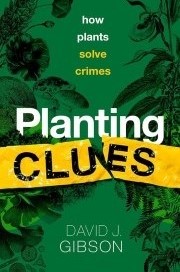Planting Clues: How Plants Solve Crimes

David J Gibson
Oxford University Press, £18.99
There are not many books on plants that open with tales of orchid thefts, abducted babies, OJ Simpson and Ted Bundy. But this is no normal plant science book – this is the story of forensic botany, the amazing scientific specialism where an intricate knowledge of plants and fungi crashes together with our need to establish what happened and when in criminal cases.
The public perception of forensic science, one suspects, remains dominated by fingerprints, suspects' DNA and blood-spatter analysis. But evidence from plants and fungi can be found everywhere, from remote graves to our internal organs, and has been used to solve crimes for as long as forensic science has existed as a distinct field. Edmond Locard, the founder of the world's first police forensic science lab in 1912, obsessively documented the various types of microscopic dust that might connect suspects to a victim or crime scene – including plant fragments and seeds, pollen and fungi. Locard was able to find a rare type of straw in a victim's eyes and blood to help solve a murder in 1925. Even before Locard, criminologists such as Hans Gross were advocating for the analysis of plant fragments in poisoning cases as early as the 1890s.
But despite this long history of helping to solve crimes, and the power of recent advances in molecular science, forensic botany is still not used as widely as it could be. Author David Gibson, a professor of plant biology at Southern Illinois University Carbondale, argues that 'plant blindness' means detectives often miss the potential of plants as evidence. A lack of resources, time, and the relevant skills within police forces further hampers its widespread use.
In Planting Clues, Gibson uses a wide range of intriguing and often high-profile criminal cases to explain the myriad clues plants and fungi can provide and the many technologies and techniques available to aid analysis. The range of things plant and fungal material can tell us is amazingly varied, and Gibson provides dozens of morbidly fascinating cases for true crime fans to chew on: could the growth of plants up through a corpse help prove that a body was dumped when the prime suspect was in jail? Could analysis of wood grains help prove a suspect made the timber ladder used in a famous and terrible abduction? It's not all grizzly murders and abductions though; forensic botany is also central to many cases involving or stolen, smuggled, or illegal plant material, from rare orchids to street cannabis to illegally logged timber.
Unsurprisingly, new technologies such as next-generation DNA sequencing, gene-editing and machine-learning are increasingly used to boost the power of traditional forensic botany. But plants' power as forensic material ultimately lies in their diversity and complexity, and so forensic botany still often relies on precise taxonomic skills and an ability to read tiny chemical and structural clues. In the intense environment of a court, botanical evidence must be bullet-proof, and Gibson enjoys discussing the credibility, relevance and admissibility of such evidence. Expert opinions differ, of course, and some of the most fascinating cases in the book involve evidence that is disputable or was later proven incorrect. This is high-stakes science for all involved.
Gibson's ultimate message is that we need to fix our 'plant blindness' – the human tendency to ignore or overlook plant species. He calls for greater awareness and training at all levels of law enforcement, and in our education systems and public life, on the fascinating ancient organisms all around us and what they can tell us.
As the pioneering forensic botanist Arthur Koehler said in 1935 about trees: "They show with absolute fidelity the progress of the years, storms, droughts, floods, injuries and any human touch. A tree never lies."
Tom Ireland MRSB
David J Gibson is a professor of plant biology at Southern Illinois University Carbondale


